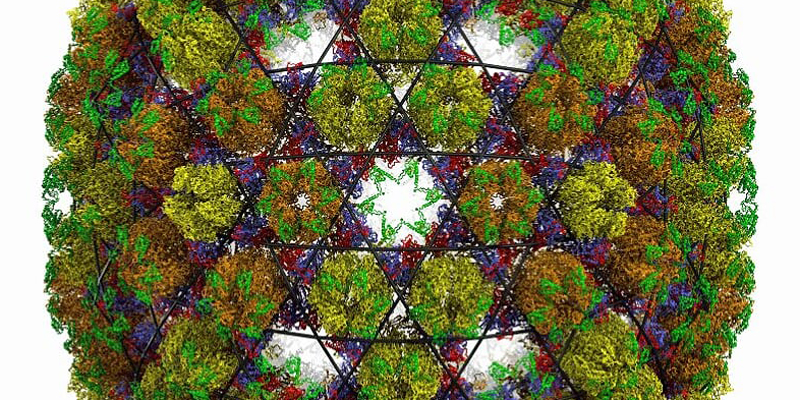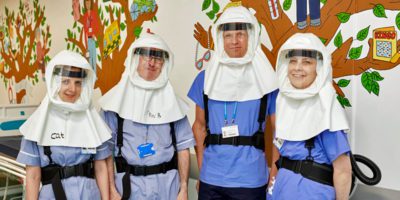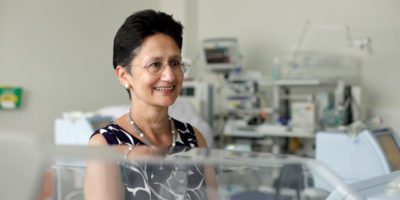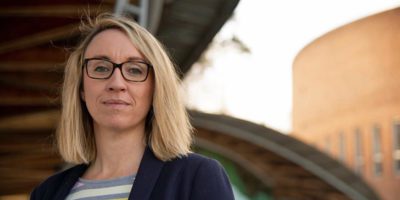Reidun Twarock is a professor of mathematical biology at the University of York, based in the York Cross-disciplinary Centre for Systems Analysis (YCCSA). Professor Twarock’s work involves developing mathematical models of viruses based on higher-dimensional lattices. In 2018, she won the Institute of Mathematics and its Applications gold medal.
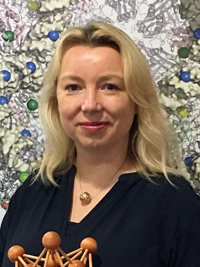
“It is a really exciting time to be working in this area, and make contributions to solving the far-reaching problems that society is faced with at the moment.”
Natural born mathematician
I have been fascinated by shapes and numbers from a very early age. As long as I can remember I wanted to be a mathematician. Pursuing mathematical problems and solving puzzles makes me profoundly happy, so that I am gravitating to it naturally… I just cannot imagine a life without mathematics!
I studied mathematics and physics at the University of Cologne in Germany where I grew up, and then obtained a MSc in Mathematics with distinction from the University of Bath.
I combined my love of mathematics and physics in my Ph.D. work in mathematical physics at the Arnold Sommerfeld Institute in Clausthal in Germany, where I won the best thesis prize and the inaugural prize of the Rotary Club Goslar Nordharz for my thesis work.
Since then, I have held a number of personal fellowships, first in Germany and then in the UK. These gave me the freedom to be creative and develop my research without distractions, and I am infinitely grateful for each of these wonderful opportunities!
A Marie Curie Fellowship brought me to the UK around 2000, and I have enjoyed working in the UK ever since.
Until 2005 I was a lecturer in mathematics at City University in London, and then a reader, and since 2009 professor of mathematical biology, at the University of York.
In 2004, an Engineering and Physical Sciences Research Council (EPSRC) Advanced Research Fellowship provided me with the opportunity to lay the foundations for the research area of mathematical virology that I pioneered.
Subsequently, a Leverhulme Trust Research Leadership Award enabled me to build up a large interdisciplinary team, combining mathematics with bioinformatics and biophysics while working in close collaboration with experimentalists. This allowed me to address research questions that none of the disciplines could tackle in isolation.
Most recently, I was awarded an EPSRC Established Career Fellowship and a Royal Society Wolfson Fellowship that are currently freeing me to fully focus on my research, addressing open problems in virology through the lens of viral geometry.
How my interest in viruses started
My exciting journey into mathematical biology began at a mathematical physics conference in Paris in 2002, where I attended a talk about icosahedral viruses by the eminent biophysicist Robijn Bruinsma from UCLA.
As icosahedral symmetry is non-crystallographic, I realised that the mathematical techniques I was working on at that time could be further developed for applications in virology.
Virologist Lars Liljas at the Biomedicum in Uppsala drew my attention to the structural puzzle of the cancer-causing papillomaviruses, that I tackled with my background in non-crystallographic symmetries and aperiodic tilings. By that time, I was hooked – it was the beginning of mathematical virology.
In 2004, I met experimentalist Peter Stockley from the Astbury Centre for Structural Molecular Biology, and we started developing our highly integrative interdisciplinary approach, making joint discoveries that neither theory nor experiment could have achieved in isolation.
We are currently joint Wellcome Trust Investigators – the only funding scheme to my knowledge that enables a theoretician and experimentalist to apply for large scale, long term funding on an equal footing.
The joy of solving mathematical puzzles, and creating mathematical concepts and approaches that can act as drivers of discovery in biology is addictive, and I take great pleasure in translating difficult biological questions into mathematics in order to render apparently intractable problems accessible.
Both the mathematical and biological questions are equally important to me. From a mathematical point of view, I particularly enjoy developing techniques that are of interest beyond the application area they have been designed for.
For example, it was nice to see that my models for virus architecture can also account for nested carbon cage structures called carbon onions, and apply to different types of protein containers in nanotechnology.
I really enjoy working in a highly interdisciplinary environment in close collaboration with other theoreticians, such as computational biophysicists, and experimentalists, and to jointly tackle complex biological questions. This enables me to develop predictive – rather than descriptive – models, that deliver insights with profound impact in virology, triggering major discoveries and overturning paradigms.
No day is the same
There is no average day at the (currently home) office – luckily! Since summer 2018 I am an EPSRC Established Career Fellow, which means that I don’t have any teaching commitments at present.
But that doesn’t make my day any less busy. Running a large interdisciplinary team with several post-doctoral research assistants (PDRAs) and Ph.D. students together with my colleagues Eric Dykeman and Rich Bingham, and working closely with the experimental team of Peter Stockley in Leeds, whilst also pursuing research projects with many other colleagues across different countries and disciplines, guarantees that every day is eventful and fun.
I love being hands-on in my projects, and I pursue many different interconnected projects that work towards a larger overarching goal. Depending on the stage a project is at, this can involve anything from mathematical work on paper, computational work, the writing up of results for publication, or the planning of new projects.
Communication with project partners is important, and there is at least one Zoom or Skype session with collaborators every day; since working from home due to the COVID-19 crisis, these sessions have become even more frequent.
The mentoring of junior colleagues and research staff is also very important to me, and I am taking an active part in their career planning, including preparations for conference presentations, and applications for follow-up positions, fellowships or other funding.
Some days involve the refereeing of research papers and grant applications, editorial work, and sometimes also work on outreach activities with artists.
For example, we are working with William Latham’s team of computer artists at Goldsmiths, who have a strong track record in showcasing their work at events such as the Viennale and open days at the Francis Crick Institute in London, to create virtual models of virus structure based on our research.
The joint work, Virus, is based on one of my more recent articles in Nature Communications on a new paradigm for virus structure modelling. It was showcased at the Lowry Gallery in Manchester in the exhibition The State of Us last year, offering an interactive virtual reality trip through mathematical models of virus architecture.
Research is a big part of my professional life
My research focuses on the development of group, graph, and tiling theoretic approaches to address open problems in virology. Through applications of these techniques either in isolation, or via novel combinations with other theoretical and experimental disciplines, I have contributed to paradigm shifts in our understanding of how viruses form, evolve and infect their hosts.
Viruses package their genetic material into protein containers, called capsids, that act akin to Trojan horses, delivering their genetic cargo into a host cell. For the majority of viruses, these capsids are organised with icosahedral symmetry.
Understanding the mathematical principles underpinning the structures and formation of icosahedral viruses poses interesting mathematical problems. I have demonstrated that their solutions act as drivers of discovery in virology, furthering our understanding of vital stages in viral lifecycles, and enabling the development of novel strategies to combat these viruses.
In particular, I introduced Viral Tiling theory to explain the structures of cancer-causing viruses, and have since developed a more general theory to tackle virus structures that are not covered by the seminal Caspar-Klug theory of virus architecture.
I have also created group theoretical techniques in order to understand virus structure at different radial levels. Using insights from that work, I developed a novel approach based on Hamiltonian paths (akin to a travelling salesman problem) to interrogate the structures of the packaged viral genomes inside their capsids.
This has been instrumental in the discovery of genome-encoded virus assembly instructions – a “virus assembly code” embedded into the genetic code – in collaboration with experimentalist Peter Stockley from the University of Leeds, and our universities jointly hold patents for the exploitation of this discovery in anti-viral therapy.
My mathematical results have also enabled novel applications in nanotechnology, for example in the context of malaria vaccines, and provide a basis for the design of virus-like particles for drug delivery and vaccination purposes.
It is a really exciting time to be working in this area, and make contributions to solving the far-reaching problems that society is faced with at the moment. My previous research has created a platform that has allowed me to discover a novel drug target against SARS-CoV-2, the virus causing COVID-19. This has recently been patented and is currently being exploited in the fight against coronaviral infections.
Winning the Institute of Mathematics and its Applications gold medal
The IMA’s gold medal has been a wonderful encouragement from the mathematical community. It means a lot to me that colleagues recognise and celebrate my achievements with me, and I can’t thank the mathematical community enough for all their continued support over the years!
It is a real pleasure to work in the highly supportive research landscape in the UK, and this award is an incentive to do even more research in mathematical virology. I hope to be able to give back to society through the novel antiviral solutions my work is enabling.
The award ceremony was a wonderful event, with all my family from Germany attending as well. 2019 was a fantastic year for our family, with my brother, Sören Twarock, winning a major award for his teaching at the Medical Faculty at the University of Düsseldorf in Germany.
Applying my knowledge to COVID-19
My work on virus structure has provided solutions for long-standing structural puzzles, and has enabled profound insights into viral life cycles that could only be achieved through the lens of viral geometry.
A very exciting recent result is the discovery of a novel type of drug target in COVID-19, that the university has recently patented. The corresponding paper is currently under review at a major scientific journal, and I am not allowed to give more details at this stage until it is accepted. It is a major advance that opens up a completely different perspective on how to tackle COVID-19 and other coronaviruses at the same time. I am actively pursuing the exploitation of this discovery together with experimentalists.
We have also developed mathematical models of within-host dynamics in a SARS-CoV-2 infection, in order to better understand how different aspects of a patient’s immune response (innate and adaptive) contribute to viral clearance and tissue damage.
This has resulted in novel insights into viral clearance in immunocompromised patients, and provides an explanation for counter-intuitive and puzzling phenomena observed during the pandemic. For example, Kawasaki’s disease, an inflammatory disease, has been reported in young children who had been infected with, and been pronounced cleared of, COVID-19.
Our models suggest that such a strong immune response can be observed under conditions characteristic of an immune response in young children even after the viral titre has dropped below detection level, i.e. when the patient has already been declared cleared of the infection.
This work also provides a computational framework to study the impact of different forms of anti-viral intervention for distinct patient groups. We have exemplified our computational framework for remdesivir, one of the drugs that are currently used against COVID-19, characterising under which circumstances remdesivir treatment is most effective. It is a pointer for policymakers how to prioritise limiting resources.
For women who would like to pursue a career in maths…
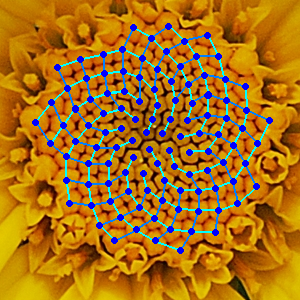
Do come and join the party – it’s a wonderful career! There are so many exciting open problems where mathematics can make a real difference in our understanding of biology – and science more broadly – and where biological questions can spur the invention of new mathematical concepts and approaches. And please don’t be deflected when other people raise doubts about a career in mathematics.
When I announced to friends and family that I was going to study mathematics at university level I was warned that this would mean I would eventually end up jobless… This is because career progression in mathematics is perhaps less clear-cut than for topics such as medicine and law. Luckily, I just loved mathematics way too much to care, and I have never regretted that decision!
If you apply your mathematical skills in the context of application areas such as virology, make sure to get a clear understanding of the fundamental open questions at the forefront of the field, so that you can make profound contributions in both mathematics and your chosen area of application.
Educating people in maths
There is a lot of wonderful material on the internet, and outlets such as the Museum of Mathematics (MoMath) in New York offer webinars and virtual classes for all age groups. I have attended a few, and thought them always to be a lot of fun!
Mathematics education is important to me, as I want to share my joy of mathematics with as many people as possible. I have therefore developed teacher’s packs together with my team, that can be downloaded for free from the ‘Teaching’ tab at the top right of my personal website at the University of York. You can use this material to explain virus architecture and symmetries to your students, and even construct some models of viruses from paper with them. There is also a form where you can leave feedback, and we are always happy to hear from you!
The future when I slowly return to ‘normal’ life
We are only just beginning to see the enormous contributions that mathematics will make in biology and other application areas in future. Subjects like physics and chemistry are traditionally intertwined with mathematics, and this relationship has triggered important developments in mathematics over the last centuries.
The many activities worldwide, developing mathematical concepts from a network, group and graph theory, geometry, topology and discrete mathematics, alongside the more traditional fields dynamical systems, ordinary and partial differential equations, for applications in biology are testimony to the fact that the same will be true for mathematics and biology. This trend is also visible in the number of new journals and conferences dedicated to different aspects of mathematical biology.
We have already seen the emergence of novel sub-disciplines in mathematical biology, such as the nascent area of molecular mathematical biology of which mathematical virology forms an integral part, and this trend is likely to continue. We are also going to see more blurring of disciplinary boundaries, resulting in mathematics being developed and applied synergistically with other theoretical and experimental disciplines in order to tackle fundamental open problems in science.
Such interdisciplinary working is an integral part of the University of York’s strategy, and the underlying philosophy of the York Cross-disciplinary Centre for Systems Analysis, where I am working.
I personally cannot wait to get to my desk every morning and work on the many fascinating projects under the auspices of my EPSRC, Wellcome Trust and Royal Society-funded research programmes. It is so exciting to be part of these developments at this pivotal time, and it feels to me as if the journey of discovery has only just begun.
https://www.york.ac.uk/maths/staff/reidun-twarock/
Yellow chamomile image credit – User:Alvesgaspar:derivative work: RDBury / CC BY (https://creativecommons.org/licenses/by/2.5)

